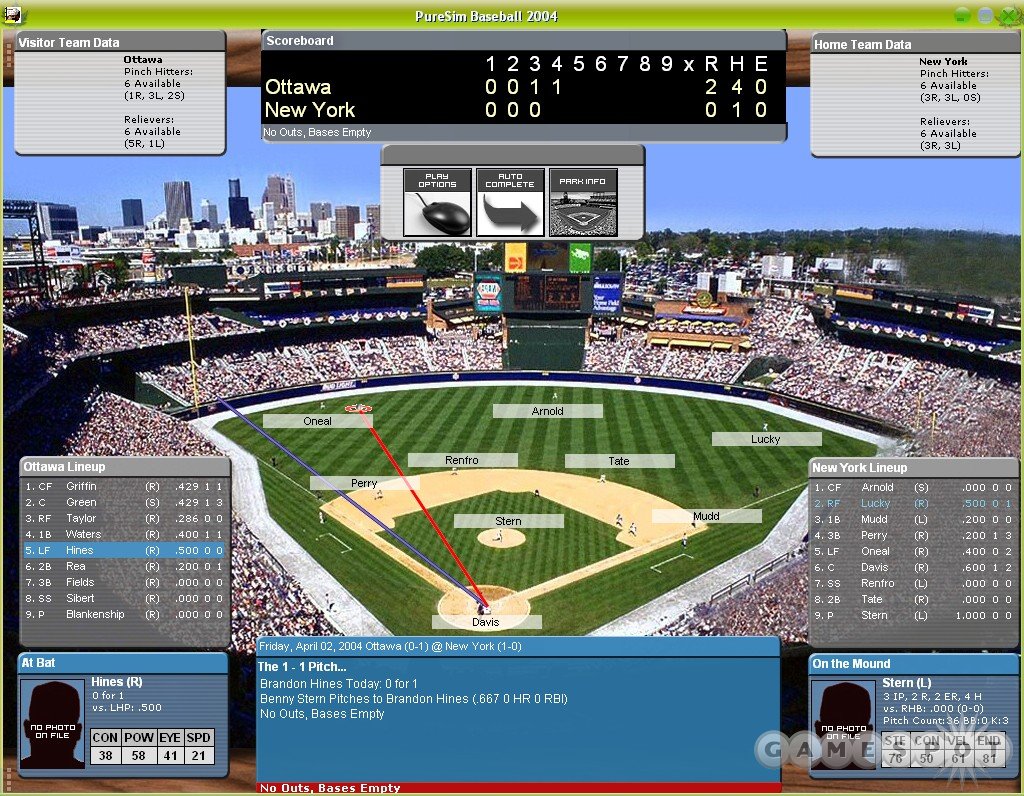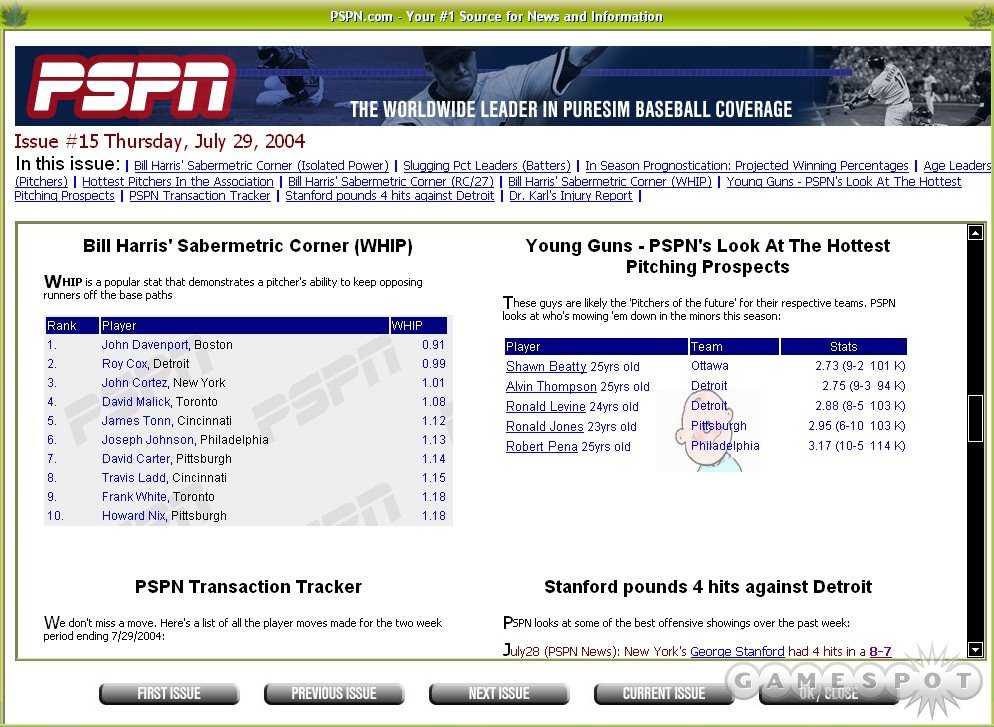Arriving just in time for the heating up of the pennant races is PureSim Baseball 2004, a sports management simulation with its own identity, although not much of a personality. Developer Shaun Sullivan's third release in this series continues to combine some of the depth of Out of the Park Baseball with the more straightforward play of Baseball Mogul, a design focus that somehow results in a captivating game that you won't confuse with either of its main influences.

From a glance, however, this is just another text-based baseball management sim. You take over a big-league ball club and orchestrate all of the moves relating to how the team does on the field. This means that you draft players, sign free agents to contracts, set up starting lineups, figure out a pitching rotation, pull the trigger on trades, and so forth.
Where PureSim 2004 steps away from the pack is in the lack of a Major League feel. The game isn't licensed by either MLB or the MLBPA, so there aren't any famous pinstripes or $250-million shortstops. That's par for the course when it comes to sports management sims, which are generally developed on a tight budget. However, in this case it really stands out because Sullivan doesn't even try to mirror the Majors. When you first set up an association, there isn't a default league that mimics the real-life show. Instead, you get options that allow you to set up the number of teams and leagues, along with a listing of well over a hundred North American cities ranging in size from San Francisco to Saskatoon. So you could be competing in big-league markets like New York and Chicago or in a semipro circuit in small-town Canada.
Oddly enough, such simplicity is a big strength. Dumping the Yankees, Red Sox, and company for the likes of the Ottawa-Gatineau Minutemen and the Omaha Sturgeon lets you focus solely on building a baseball club. It's refreshing to play a pure fantasy baseball game without the static provided by having to re-create real-world performances of players, stage bobblehead promotion days, or deal with petulant outfielders. Gameplay is about developing a winning lineup, not wheeling and dealing and struggling with arcane subjects like the Rule 5 draft. Even contract negotiations are simplified, with players signing fixed-term deals for the most part.
Of course, you're covered if you want to reenact real pennant races, too, as PureSim 2004 allows use of the acclaimed Sean Lahman database. This downloadable file features full pitching and batting statistics for every single player in MLB history. Get it for free from the Baseball1.com Web site and you can start an association with authentic pros from every season between 1871 and the present day.
No matter whether you prefer fictional or real, or modern or historical, there are a wealth of configuration options. The new ballpark designer lets you whip up your own stadium, and it even lets you include a photograph of the park for use on the simulation screen. Almost everything about the nuts and bolts of the game can be customized with the editable XML file. So if you want to create a more realistic semipro league or go back in time to a pre-Curt Flood MLB, drop salaries. Or you can drop cash entirely and swap dollars for the old PureSim system that used points to represent player value. On-field results can also be tweaked. Want to re-create the Dead Ball era or live through the run-happy 1990s? Play with the numbers governing hits, walks, and homers.
Gameplay is solid no matter how you adjust the settings. Much progress has been made over the past two editions of the game, most notably in the area of sim speed. Previous editions were slowpokes, requiring minutes to simulate a week of games. The new game is a roadrunner by comparison, zipping through a week in under 30 seconds. Where PureSim was once the slowest kid on the baseball simulation block, it's now leaving competitors like Out of the Park Baseball 6 in the dust. A new option, which forgoes the minor leagues and cuts back to a single 35-man roster, makes the game run even faster.
Lack of personality remains a problem, though. Sullivan has taken his "Pure baseball" slogan too literally and left the game devoid of little touches. Negotiating with players is the biggest flaw. Unless you're in the fall-winter free-agent period (when you have the added option of using a slider bar to increase the money offered per year of contract), all you can do is pick a fixed-term deal. This doesn't leave any room for back-and-forth dealing, so there is no tension during the free-agency period or when it comes to trying to re-sign stars. There isn't an e-mail system to communicate with players and other general managers, either, which further depersonalizes the proceedings. Only the PSPN magazine, which summarizes events across your association and even includes such esoteric items as sabermetric numbers, provides signs of life beyond the stats.
This bland character is somewhat balanced by a new, more functional interface. Icons at the bottom of the main screen lead directly to all of the primary menus, such as standings, the stat almanac, highlights, and player transactions. The PSPN Game Cast game sim screen is now very attractive, with a background shot of a big-league ballpark, graphics indicating every hit, and sidebars detailing player stats. It even includes head-and-shoulder icons where player photos can be placed, giving the game a TV-broadcast feel. Still, the interface is somewhat clunky. Player face packs have to be downloaded separately, so you're stuck with silhouettes in the beginning, and the sans serif fonts give most screens the character of a spreadsheet.

But at least stats aren't an issue. PureSim 2004 is dead-on the money when it comes to generating numbers. At least, as dead-on as you want when playing a sports sim. There is some measure of unpredictability to player performance. Although each player comes with over a dozen skill ratings, they aren't the complete measure of a ballplayer. So you can get burned on big-money sluggers with incredible scores in power and contact, and rookies who never live up to potentially high ratings. Generally, though, players perform within acceptable margins. A second baseman with contact and eye scores in the 70s will at least flirt with .300 every season; an outfielder with a power score above 80 will routinely count 30 to 40 dingers; and a starting pitcher with control in the 80s can be expected to win close to 20 games with a good team backing him up.
All in all, PureSim Baseball 2004 shows that developer Shaun Sullivan is building an impressive, if somewhat modest, baseball management simulation franchise. Some options will be missed by some players--especially those coming from a more intricate simulation like Out of the Park Baseball 6, which also offers the online league play that this game lacks--but the strict focus on nothing but baseball is a treat for those tired of sports sims filled with so many intricacies that it becomes hard to see the sport.